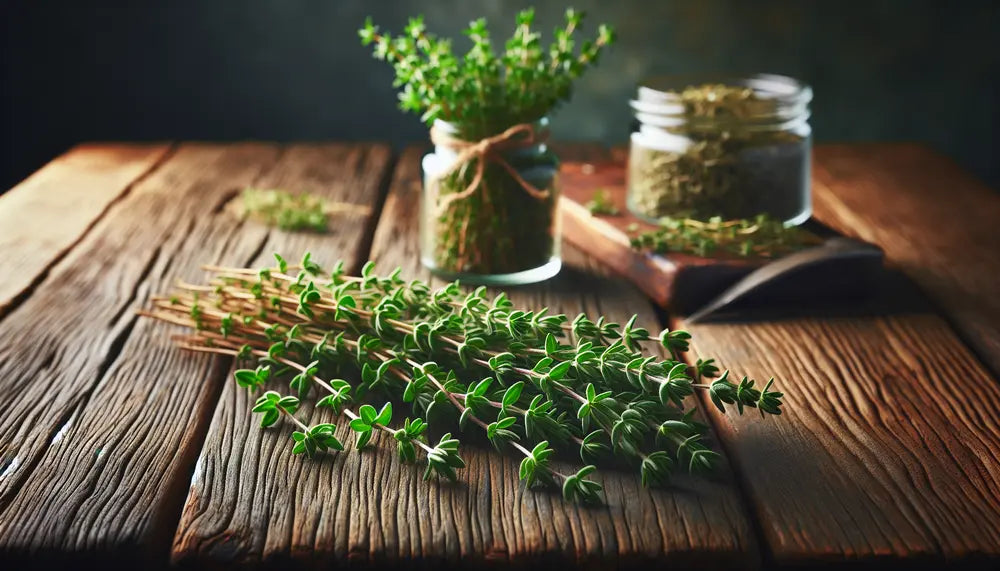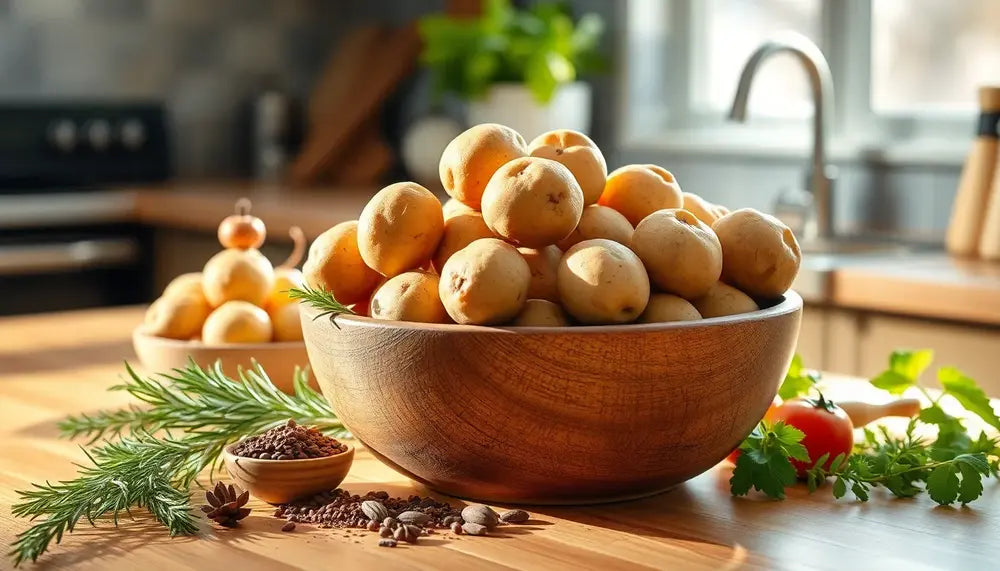Introduction
Thyme is a versatile one Spice, which is valued in many cuisines worldwide. In this article you will learn everything you need to know about it Spice thyme. From its history to the different types of uses to its health benefits. This article offers you a comprehensive overview and practical tips on how to best use thyme in your kitchen. Whether you're a beginner or an experienced cook, you'll find valuable information here to help you get the most out of this classic Spice to get out.
What is thyme?
Thyme is an aromatic Spice, which is obtained from the leaves and flowers of the thyme plant (Thymus vulgaris). This plant belongs to the mint family and is native to the Mediterranean region. Thyme is often used in dried form, but can also be used fresh. The small, green leaves have an intense, slightly earthy taste that goes well with many dishes.
Thyme is an integral part of the Spice mixtures like the herbs of Provence and is often used in Mediterranean recipes. There are different types of thyme, but common thyme is the most common. It is characterized by its versatility and its characteristic taste.
The story of thyme
Thyme has a long and rich history dating back to ancient times. The ancient Egyptians already used thyme for religious rituals and for embalming. The Greeks and Romans also highly valued thyme. They used that Spice not only in the kitchen, but also as medicine and incense.
In the Middle Ages, thyme found its way to Europe and was cultivated in monastery gardens. The monks used thyme for medicinal purposes and as an ingredient in healing potions. Over the centuries, thyme became increasingly popular and found its place in European cuisine.
Today thyme is known worldwide and is used in many different cuisines. Its versatility and unique aroma make it an essential Spice in the modern kitchen.
Use of thyme in cooking
Thyme is extremely versatile Spice, which is used in many different dishes. Its intense aroma and slightly earthy taste make it a popular ingredient in Mediterranean cuisine. Here are some of the most common uses of thyme in cooking:
- Soups and stews: Thyme adds a deep, aromatic note to soups and stews. Simply cook a few sprigs and remove them before serving.
- Meat dishes: Thyme goes particularly well with poultry, lamb and beef. It can be used for both frying and grilling.
- Fish and seafood: Thyme goes well with fish and seafood. It can be used in marinades or directly when cooking.
- Vegetables: Thyme goes well with roasted or steamed vegetables. It gives the vegetables an additional flavor dimension.
- Sauces and dressings: Thyme can add a special touch to sauces and dressings. It can be used fresh or dried.
Thyme is also an important ingredient in many Spice mixtures and can be combined with other herbs such as rosemary, oregano and basil. No matter whether you use it fresh or dried, thyme always brings a special touch to your dishes.
Aroma and taste of thyme
Thyme has a distinctive aroma and unique taste that sets it apart from others Seasoning takes off. Its scent is intense and slightly earthy, with a subtle sweet note. This combination makes thyme a popular one Spice in many kitchens worldwide.
The taste of thyme is strong and spicy, with hints of lemon and mint. This complex flavor adds depth and character to many dishes. Thyme can be used both fresh and dried, although the dried version often has a more intense taste.
Here are some of the distinctive flavors of thyme:
- Spicy: Thyme has a strong, spicy note that goes well with savory dishes.
- Earthy: The earthy undertones give this Spice a robust depth.
- Lemony: A light hint of lemon brings freshness to the dishes.
- Minty: The subtle mint note rounds off the taste and ensures a pleasant freshness.
Thyme is a Spice, which is versatile and gives many dishes a special touch. Its complex aroma and unique taste make it an indispensable ingredient in the kitchen.
Health Benefits of Thyme
Thyme is not just tasty Spice, but also offers numerous health benefits. Its ingredients have various positive effects on the body. Here are some of the top health benefits of thyme:
- Antioxidant properties: Thyme contains many antioxidants that help fight free radicals in the body. These can prevent cell damage and reduce the risk of chronic diseases.
- Antibacterial effect: Thyme has natural antibacterial properties. It can help fight harmful bacteria and prevent infections.
- Anti-inflammatory: The compounds found in thyme can reduce inflammation in the body. This can be helpful in relieving inflammatory conditions such as arthritis.
- Immune system support: Thyme is rich in vitamin C and other nutrients that strengthen the immune system. A strong immune system can fight off diseases better.
- Promotes digestion: Thyme can support digestion and relieve stomach problems. It stimulates the production of digestive juices and can reduce flatulence.
Thyme can be consumed in a variety of ways to reap its health benefits. It can be brewed as a tea, incorporated into food, or used as an essential oil. No matter how you use it, thyme can make a valuable contribution to your health.
Buying and storing thyme
When buying thyme you have the choice between fresh and dried Spice. Both variants have their advantages and can be used as needed. Here are some tips on how to best buy and store thyme:
- Fresh thyme: Make sure the leaves are green and not wilted. Fresh thyme should have an intense scent. You can find it in the vegetable section of your supermarket or at the weekly market.
- Dried thyme: Dried thyme has a longer shelf life and a more intense taste. Make sure to store it in an airtight container to preserve its flavor. You can find it in the spice section of your supermarket.
Proper storage is crucial to maintaining the quality and aroma of thyme:
- Fresh thyme: Wrap the thyme sprigs in a damp cloth and store them in the refrigerator. This way it stays fresh for up to a week. Alternatively, you can freeze fresh thyme. Place the branches in a freezer bag and freeze them. This way it lasts for several months.
- Dried thyme: Store dried thyme in an airtight container in a cool, dark place. This way it stays aromatic for up to a year. Avoid direct sunlight and moisture to prevent mold growth.
With these tips you can ensure that your thyme always stays fresh and aromatic. Whether you use it fresh or dried, proper storage is key to getting the most out of this versatile Spice to get out.
Recipes with thyme
Thyme is a versatile one Spice, which gives many dishes a special touch. Here are some simple and delicious recipes where thyme plays a starring role:
- Thyme Honey Chicken: Marinate chicken breast fillets with a mixture of honey, lemon juice, olive oil and fresh thyme. Let the marinade take effect for at least an hour and then grill the chicken breast fillets. The result is a juicy, flavorful dish that goes perfectly with rice or salad.
- Roasted Potatoes with Thyme: Cut potatoes into small cubes and mix them with olive oil, salt, pepper and dried thyme. Spread the potatoes on a baking tray and roast them in the oven at 200°C for about 30-40 minutes until golden brown and crispy. This side dish goes well with many main dishes.
- Thyme and lemon fish: Place fish fillets (e.g. salmon or cod) in a baking dish and drizzle with lemon juice and olive oil. Sprinkle the fillets with fresh thyme, salt and pepper. Bake the fish in the oven at 180°C for about 20 minutes until cooked through. Serve it with steamed vegetables or a fresh salad.
- Thyme and carrot soup: Sauté onions and carrots in a pot with a little olive oil. Add vegetable broth, fresh thyme and a pinch of salt. Let the soup simmer until the carrots are soft. Puree the soup and season with salt and pepper. This creamy soup is perfect for cold days.
- Thyme herb butter: Mix softened butter with chopped fresh thyme, garlic and a pinch of salt. This herb butter goes perfectly with grilled meat, fish or simply on fresh bread.
These recipes show how versatile thyme can be used in the kitchen. Try them and discover how this one does Spice gives your dishes a special touch.
Conclusion
Thyme is an essential Spice in the kitchen, which impresses with its intense aroma and unique taste. From soups and stews to meat and fish dishes to vegetables and sauces - thyme gives many dishes a special touch. Its health benefits, such as antioxidant and anti-inflammatory properties, also make it a valuable component of a healthy diet.
Whether fresh or dried, thyme is easy to purchase and store. With the right tips, it stays aromatic and fresh for a long time. The versatile recipes show how easy it is to use thyme in the kitchen and benefit from its numerous benefits.
Overall, thyme is a classic Spice, which should not be missing in any kitchen. Try it out and discover how thyme takes your dishes to a new level of flavor.
Frequently asked questions about thyme
What is thyme?
Thyme is an aromatic spice that is obtained from the leaves and flowers of the thyme plant (Thymus vulgaris). It has an intense, slightly earthy taste and is an integral part of many spice mixtures such as herbs de Provence.
How is thyme used in cooking?
Thyme is a versatile spice used in soups, stews, meat dishes, fish, vegetables and sauces. It can be used both fresh and dried to give dishes a special touch.
What health benefits does thyme provide?
Thyme has antioxidant, antibacterial and anti-inflammatory properties. It can boost the immune system, aid digestion, and even help relieve inflammatory conditions like arthritis.
What is the best way to buy and store thyme?
Fresh thyme should be green and fragrant, dried thyme is stored in airtight containers. Fresh thyme can be stored in the refrigerator or frozen, while dried thyme should be stored in a cool, dark place.
What types of thyme are there?
There are different types of thyme, with the common thyme (Thymus vulgaris) being the most common. Other types include lemon thyme and woolly thyme, each of which has its own distinctive flavors.





Share:
Wild boar tender and juicy: suitable marinades for the grill
Enjoyable foreplay: Marinade for antipasti that tempts every palate